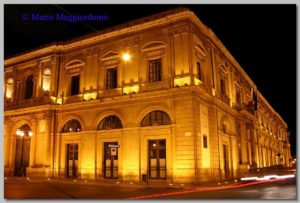Palazzo del Carmine

Il Palazzo del Carmine è l’attuale sede del Municipio e, insieme alla Cattedrale e a San Sebastiano, è una delle tre grandi costruzioni che rappresentano lo sfondo di Piazza Garibaldi.
La sua struttura ebbe origine diversi secoli fa. Verso la fine del XIV secolo, e precisamente nel 1371, venne fondato il Convento dei Carmelitani Scalzi. A questo era annessa la chiesa dell’Annunziata, detta anche del Carmine. A seguito della soppressione delle corporazioni religiose [esiste una versione romanzata, nel caso voleste approfondire] e dell’espulsione dei Padri Carmelitani, il Comune destina i locali del Convento e la Chiesa dell’Annunziata (Chiesa del Carmine) a sede municipale. Inizialmente, la chiesa fu destinata a cappella del Municipio mentre nel 1887 fu demolita. Il prospetto che si affaccia sulla Piazza Garibaldi venne ristrutturato nel 1876 mentre, qualche anno dopo, su progetto dell’ingegner Enrico Arcatisi, venne ristrutturato anche il prospetto che dà su Corso Umberto I.
La facciata presenta una impostazione classica, con una serie di arcate al piano terra e lesene binate di stile corinzio con timpani curvi o triangolari al piano superiore.

